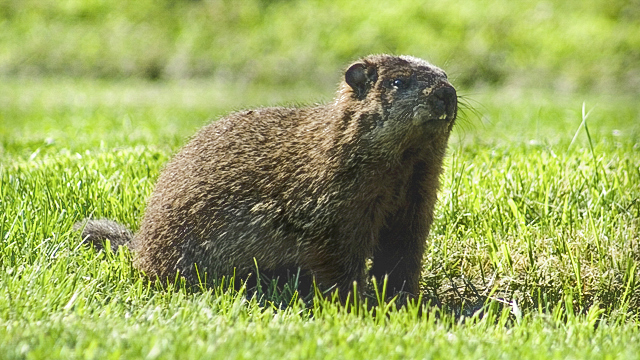Groundhog (Woodchuck)
Scientific Name: Marmota monax
The groundhog belongs to a group of large ground sqirrels known as marmots.
Fun Fact: Every year on Feb. 2nd. in Pennsylvania, a groundhog named Punxatawney Phil determines if there will be an early spring depending on whether or not he sees his shadow.
Lifespan: Can live up to 6 years but 2-3 is average.
Description
Groundhogs are rodents and are also referred to as chucks, wood-shocks, groundpigs, whistlepigs, whistler, thickwood badger, Canada marmot, monax, moonack, weenusk and red monk. It is found throughout much of the Eastern United States. Adults are 16-20 inches and are between 5 and 12 pounds. They have 4 sharp incisor teeth which grow approx. 1/16th inches per week. Constant gnawing wears them down by about the same amount each week.
Groundhogs are great diggers using their short, powerful limbs and thick curved claws. The tail on the groundhog is much shorter than on other members of the squirrel family being only about 1/4 of the length of the body.
Diet
Groundhogs eat more than a pound a day of mostly vegetable matter including wild grasses, berries and agricultural crops like corn. They will also eat snails, insects and baby birds if they come upon them by accident. Unlike squirrels, groundhogs don’t store food. They stuff themselves so they can survive the winter without eating. Groundhogs are thought not to drink water but instead get their liquids from the juices of food plants sometimes with the aid of dew or rain that coats leaves after a shower.
Behavior
The habits of groundhogs are not fully understood because they hide when they see, smell or hear humans. Even though grounhogs look fat, they are pretty good swimmers and have been known to climb trees to check out their surroundings or escape from predators. Underground burrows, however, are their preferred hiding spot. If the burrow is attacked or invaded, groundhogs will furiously defend itself with its strong, curved front claws as well as their sharp front incisors. Groundhogs are diurnal meaning that they are most active in the morning or late afternoon.
Hibernation
Groundhogs are one of the only species that enter into true hibernations. They often will build a winter burrow that is concealed in a brush filled or woodland area. It is dug below the frost line (approx. 4 feet deep) and keeps the temperature above freezing during winter. Hibernation occurs between October to March. By the time they wake up, they may have lost as much as half of their body weight.
Reproduction
Groundhogs usually breed in their second year. The breeding season begins in March after hibernation. Both male and female will stay in the same den for about a month then the male will leave the female and go out on his own. Usually only one litter of 2 to 6 is born. The offspring are blind, hairless and unable to take care of themselves. They rely completely on the female for their well being. When the babies fur grows in, the mother will introduce them to the wild to begin survival training. Sometimes, the father groundhog will show up to help the family but this is not always the case. By the end of summer, the family breaks up to prepare for winter hibernation on their own.
Other Interesting Groundhog Facts
- The burrowing of groundhogs can sometimes undermine the foundation of houses and other outdoor human structures
- Other animals like skunks, rabbits and red foxes will often share a groundhog burrow
- Groundhogs can be raised in captivity but it is not recommended as they do have an aggressive nature
- Occasionally, groundhogs have turned up interesting acheological finds because their burrow digging turns over the soil so completely,
How to Get Rid of Ground Hogs
Fencing
Fencing off gardens and flower beds is probably the most humane way to thwart groundhogs. In order to place an effective barrier, use 3″ chicken wire and bury it at least 18″ below ground and approx 2 feet high. Groundhogs like to dig so the deeper the barrier, the better.
Cage Traps
Getting rid of groundhogs can be easier if you get some live traps. These traps are made of metal and have a swing down door that traps the groundhog when he feeds off the bait in the back of the cage. Wire up the cage door for the first few days so it can’t close and let the groundhogs get used to a free meal. Once they have lost their fear of the cage, set the door as per instructions. Once you have caught your groundhog, cover the cage with a cloth during transport to a suitable area to release it.
Fumigation
There are products available that fumigate ground hog holes. These fumigation products also work on squirrels, rabbits, skunks and other animals that live in burrows. The fumigation is accomplished by dropping the gas cylinders down the hole and covering all entrances and exits with soil to trap the poison gas inside. Fumigation should be done in late April and early May before the young leave the nest. This method should not be used if the burrow is under any residential structures for obvious reasons.
(706) 221-8000
Request Free Pest Inspection
EMERGENCY SERVICE AVAIALBLE
Request Free Pest Inspection
EMERGENCY SERVICE AVAIALBLE


